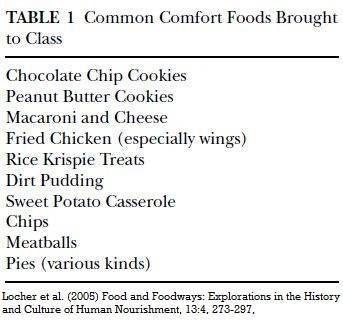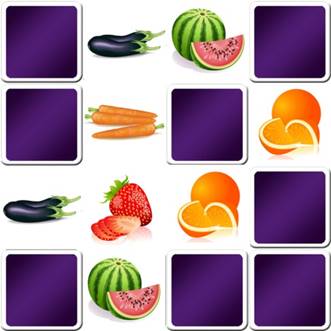THE OBSERVATIONAL STUDY
Sample: 264 undergraduate students attending a large urban public University in the Southeast in USA, members of Introduction to Sociology class or Social and Cultural Aspects of Food and Eating class.
Students were required to bring food object that “made them feel good” or “provided them comfort” to share with the rest of the class, explaining their choice.

Similarities among chosen foods –keywords
-
NEED OF AN EMOTIONAL PICK and SELF-ESTEEM
“My grandmother always make my homemade chocolate ice cream when I am sad, now when I am feeling down, I eat ice cream to make me feel better“.
Some participants used food for comfort when they felt low in self-esteem. “The receipt of a meal is often perceived as a reception of the person offering the meal.” - INDULGENCE, perceptions either in terms of the food item’s expense or the item’s richness in terms of caloric, fat, and sugar content. They noted concerns about health and nutrition, but ignored them, not allowing issues related to health to enter their selection decisions. They experience these kind of food as a motivator or reward for getting through difficult experiences, such as a mid-term or final.
-
FAMILIARITY, Intimate social exchanges occurring among close friends and family members while preparing and consuming foods might be viewed as “kitchen therapy.”
“When I lived at home, my mother always fixed fruit salad ”
“Mom, who cooked every day, would add corn to every meal. ”
-
NOSTALGIC FOOD, identifying a particular time and place in one’s history. Nostalgic foods often were linked to memories of being cared for by another.
“Now that I live far from my family, blueberry muffins still remind me of Saturday morning chats. If I’m feeling lonely, I can pull out a mix and memories of my family instantly comfort me.” -
NO ONE ELSE AROUND
Respondents reported they almost always consumed comfort foods while alone. -
CONVENIENCE FOOD
“When I am feeling depressed . . . I want something that is convenient. It is more convenient for me to go to the store and buy some cheese curls than it is for me to go in the kitchen and cook.”
Some differences were found by gender. For example, women in the sample were more likely to select foods that were associated with the preparation of the food with significant others (e.g., salads) or that they received as gifts (e.g., chocolates), whereas men were more likely to select foods that were whole meals or foods that had been prepared by others (either mothers or lovers) (e.g., jambalaya or chocolate chip cookies). Alcohol was also cited by men as a «comfort beverage» during periods of sadness.
In sum comfort foods are familiar to the individual and used only on special occasions, most notably when feeling sad or depressed or when alone. They may evoke feelings of nostalgia, are usually convenient to prepare and consume, are often indulgent, and typically provide a sense of both physical and emotional comfort. Although the generalizability is limited by some biases that might be found in age, region, and social, economic, and cultural capital, study findings’ significance is not limited.
And you which food you would chose to explain your self-help behaviour in a period of sadness? First course, second course, or dessert? Chose and rank 3 of these options.
1°
2°
3°

We can bear in mind some study suggestions, such as the role of food and emotions together in managing relationships and the interesting role of memory in linking emotional aspects and food choices.
The feelings evoked by sharing food in the formation of relationships, are maintained over time with or without the presence of others. Thus, in a very important way, food acts as a mediator for social relationships that exist within the larger social order.
The feelings evoked by sharing food in the formation of relationships, are maintained over time with or without the presence of others. Thus, in a very important way, food acts as a mediator for social relationships that exist within the larger social order.
Furthermore one common, indulgent comfort food reported by both male and female students in Locher et al. 2005 study was chocolate, a very popular food for comfort.
Go to chocolate research studies Back to Chocolate Back home
